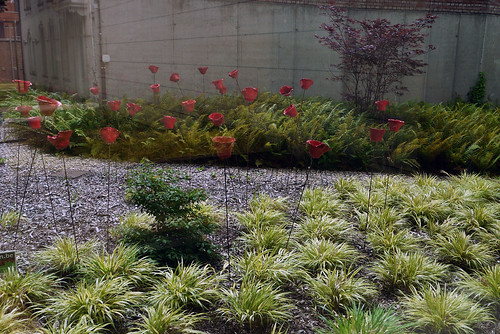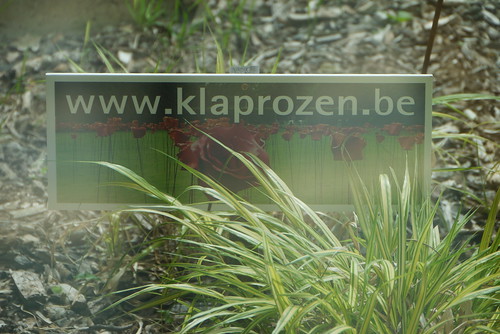During my visit to the M Museum in Leuven I noticed these poppies through a museum window. They reminded me of the poppies in the moat at the Tower of London. When I got home I looked up the website that was advertised to find out more about them:
Poppies for Peace is based on an initiative taken by ceramic artist Anita Huybens (1949-2008):
“For quite a while I wanted to do something dealing with amputation and the loss of one’s abilities as a consequence. Losing a part of your body and learning how to live that way … is painful and difficult, I know. An encounter helped to enable me to, as well as dare to, work on this theme. On one of my Raku-firing days Mic Billet told me about his Apopo-project. A group of ‘inspirators’ worked on developing a method using rats to track and deactivate landmines in former warzones. Thus, it was possible to prevent the trackers and the local residents from having more limbs torn off. This story coincided with the amputation project which had been in the back of my mind for a long time. It emerged as the image of a field full of poppies.
Poppies remind us of the battlefields in WWI during which the bodies of so many were shot to pieces. Poppies remind us of the symbolic meaning which the British attached to them in order to make sure that the dead would not disappear into oblivion. Poppies remind me of my childhood, when I gathered a bunch of them for my grandmother who accepted them as a great present. Because of all these intense experiences, I grew towards the decision to make a field of 1000 ceramic poppies…it’s as if I feel compelled to do this …now, in this life I can still live.
Apopo is an initiative of researchers in Belgium and Tanzania. They developed a totally new method to train giant pouched rats and involve them in the tracking of landmines. The rats are first trained in order to recognise the scent of explosives in order to later detect mines in fields.
At present Apopo is active in Mozambique. Since the operations started, 280 hectares have been cleared of landmines. 280 hectares of farmlands, villages and roads can again be accessed by the locals.
Spending the funds:
‘vzw Klaprozen voor Vrede’- ‘Poppies for Peace non profit’ collected enough funds in the past years to finance a first bushcutter. This appliance is first used to free up the overgrown areas after which the rats can do the tracking. In later years a second bushcutter could be purchased. At present, the funds raised by selling the ceramic poppies are spent on the intensive training of the rats and their supervisors. A realistic figure : €5000 is needed for the training of one single rat which is the revenue of selling 100 poppies.
The photo quality suffers a little because I had to photograph the poppies through a glass window.










Poppy day, eh?
Rats are not only able to detect landmines. First of all, they would not come up with the perverse idea to produce any.
In this case the poppies have been made to serve as a reminder and to stop further casualties due to the result of the human fixation of war.
Anita Huybens started a very wonderful program by making her ceramic poppies for peace… it’s wonderful to see how they learned to find the landmines with trained rats… good photo and a wonderful cause Cherie….peter:)
I am quite fascinated as to how they might have trained the rats to do that!
If that’s a photograph “suffering” then what of the “good” ones?
The good ones have more vibrant colours
And very effective here, too, Cherie
I like the photographs of the project on their website. Some are quite moving
A wonderful photo and project
Thanks Donna
I love poppies,especially orange Icelandic poppies.
I did not know they symbolized bits of blown up soldiers in the fields from WWI. Thanks. Fascinating read.
The poppy in this context is a remembrance of both WW1 and WW2:
http://www.britishlegion.org.uk/remembrance/story-of-the-poppy?gclid=CPqnnYL1zsYCFUGJ2wodh00NNA
Others have taken the theme to mean different things and take on a different emphasis for them.
You made a lot of photographs in Leuven – I think it was a wonderful time.
Sigrun
I did take rather a lot of photographs and yes we had a good time
Oh we should have posted this together.
Yes